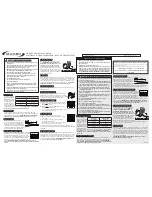
孚IRCLE
®
GASOLINE CYLINDER COMPRESSION TESTER
(9
PCS)
l111��l�1l1l��[·l��-
I. PREPARATION
1. Start engine for approximately 10 minutes or until engine reaches normal working temperature.
2. Turn off the engine. Disconnect first cylinder spark plug wire and mark cylinder number on the wire.
3. Remove spark plug (Fig. 1) and place it onto a clean surface. Check spark plug conditions. Change a new one if
necessary. Clean spark plug hole.
NOTE: Spark plug cond巾ons may also serve as an indication to the cylinder condition and compression pressure.
4. Disconnect the central high tension (HT) lead on the distributor and connect it to ground. On Electronic Ignition System,
remove electronic ignition device (Fig. 2) or ignition coil. On GM High Energy Ignition (HEI) system, disconnect the main
wire on distributor cap.
II. COMPRESSION PRESSURE TEST
Method A
1. Choose a suitable adapter and connect the adapter to a rubber test hose.
2. Screw the adapter and rubber test hose onto the spark plug hole.
Method B
1. Choose a suitable aluminum test tube.
2. Install the aluminum test tube on the spark plug hole.
NOTE: When using the aluminum test tube (angled or straight), one hand must hold and press against the test tube on the
spark plug hole at all time (Fig. 3)
3. Connect the gauge onto the rubber test hose or aluminum tube.
4. Start the engine to run at least 4 compression strokes or until the pressure gauge reading remains at a fixed level.
5. Record the pressure reading.
6. Press pressure release button before disconnecting from the cylinder.
7. Install the spark plug and wire back to the cylinder.
8. Test other cylinders one by one, and compare the test results.
丨
TEST RESULTSj
1. The pressure should become higher after each compression stroke then up to maximum under normal conditions. The
pressure of each cylinder in the same engine should follow the standards set by the auto manufacturer.
2. If the pressure does not become higher after several compression strokes, then the valves could be clogged.
3. The highest pressure and the lowest pressure should not be more than 20 psi or 15%.
4. If the pressure is much higher than the standard set by the manufacturer, then there could be carbon deposits.
5. If the pressure in one cylinder is significantly lower than other cylinders, put a teaspoon of SAE30 engine oil into the
cylinder.
- If the pressure increases much, piston rings could be worn out or the cylinder head is not appropriately installed.
- If the pressure remains the same, the valves could be worn out or out of adjustment.
`
丶
震
\
.,...�
...
.
!
,
'J
t
�
�
/
.
-·
�.:-.'
·.:
-....:..
'-rt-
""
_,
二
.
,了`
丶
�
-
丶
x
,-
,,,
一
一
F ·
.tr
1111.m.
Fig. 2
c::
】
Fig. 3
www.9circleint.com


























